miR-23a 在白血病患者 CD4 T 细胞中介导的 TRF2 抑制作用
IF 3
3区 医学
Q2 BIOCHEMISTRY & MOLECULAR BIOLOGY
引用次数: 0
摘要
接受抗逆转录病毒治疗(ART)的HIV感染者(PLWH)的CD4 T细胞通常表现出炎症表型,其特征是持续炎症、免疫激活、衰竭、衰老和凋亡。我们之前已经证明,抑制端粒重复因子2 (TRF2)蛋白会导致PLWH中端粒侵蚀加速和CD4 T细胞过早衰老。在本研究中,我们进一步研究了PLWH对TRF2蛋白在CD4 T细胞中的抑制作用,重点研究了mirna介导的机制。我们发现,与健康受试者相比,PLWH的CD4 T细胞中miR-23a显著增加,而TRF2蛋白被抑制(HS)。生物信息学分析显示,TRF2 3'UTR是miR-23a的潜在靶点。将miR-23a与含有TRF2 3'UTR的荧光素酶构建体共转染HEK293T细胞,发现miR-23a抑制TRF2蛋白的翻译。值得注意的是,PLWH和HS的CD4 T细胞中的T细胞受体(TCR)激活增加了miR-23a并降低了TRF2蛋白的表达。此外,HS中CD4 T细胞中miR-23a的增加导致TRF2蛋白水平的降低和细胞凋亡的增加——这一表型与我们在PLWH中观察到的相似。此外,PLWH的CD4 T细胞中miR-23a的敲低增加了TRF2蛋白水平,而不是TRF1蛋白水平。这些结果表明,miR-23a负调控TRF2蛋白在CD4 T细胞中的表达;因此,靶向miR-23a可提高PLWH中TRF2蛋白水平,从而保护端粒完整性,恢复CD4 T细胞功能。本文章由计算机程序翻译,如有差异,请以英文原文为准。
miR-23a-mediated TRF2 repression in CD4 T cells from PLWH
CD4 T cells in people living with HIV (PLWH) on antiretroviral therapy (ART) often exhibit an inflammaging phenotype, characterized by persistent inflammation, immune activation, exhaustion, senescence, and apoptosis. We have previously demonstrated that inhibition of telomeric repeat factor 2 (TRF2) protein causes accelerated telomere erosion and premature CD4 T cell aging in PLWH. In this study, we further investigated how TRF2 protein is inhibited in CD4 T cells from PLWH, focusing on the miRNA-mediated mechanism. We found that miR-23a is significantly increased, whereas TRF2 protein is repressed, in CD4 T cells from PLWH compared to healthy subjects (HS). Bioinformatics analysis revealed that the TRF2 3’UTR is a potential target of miR-23a. Co-transfection of miR-23a with a luciferase construct containing TRF2 3’UTR into HEK293T cells revealed that miR-23a suppresses TRF2 protein translation. Notably, T cell receptor (TCR) activation in CD4 T cells from both PLWH and HS increased miR-23a and decreased TRF2 protein expression. Furthermore, increasing miR-23a in CD4 T cells from HS led to a decrease in TRF2 protein level and an increase in cellular apoptosis - a phenotype similar to what we observed in PLWH. Moreover, the knockdown of miR-23a in CD4 T cells from PLWH increased TRF2, but not TRF1, protein levels. These results suggest that miR-23a negatively regulates TRF2 protein expression in CD4 T cells; thus, targeting miR-23a may increase TRF2 protein level, and thereby protect telomere integrity and restore CD4 T cell functions in PLWH.
求助全文
通过发布文献求助,成功后即可免费获取论文全文。
去求助
来源期刊

Molecular immunology
医学-免疫学
CiteScore
6.90
自引率
2.80%
发文量
324
审稿时长
50 days
期刊介绍:
Molecular Immunology publishes original articles, reviews and commentaries on all areas of immunology, with a particular focus on description of cellular, biochemical or genetic mechanisms underlying immunological phenomena. Studies on all model organisms, from invertebrates to humans, are suitable. Examples include, but are not restricted to:
Infection, autoimmunity, transplantation, immunodeficiencies, inflammation and tumor immunology
Mechanisms of induction, regulation and termination of innate and adaptive immunity
Intercellular communication, cooperation and regulation
Intracellular mechanisms of immunity (endocytosis, protein trafficking, pathogen recognition, antigen presentation, etc)
Mechanisms of action of the cells and molecules of the immune system
Structural analysis
Development of the immune system
Comparative immunology and evolution of the immune system
"Omics" studies and bioinformatics
Vaccines, biotechnology and therapeutic manipulation of the immune system (therapeutic antibodies, cytokines, cellular therapies, etc)
Technical developments.
 求助内容:
求助内容: 应助结果提醒方式:
应助结果提醒方式:


